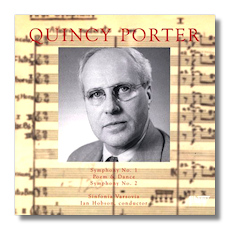
The Internet's Premier Classical Music Source
Related Links
- Porter Reviews
- Latest Reviews
- More Reviews
-
By Composer
-
Collections
DVD & Blu-ray
Books
Concert Reviews
Articles/Interviews
Software
Audio
Search Amazon
Recommended Links
Site News
 CD Review
CD Review
Quincy Porter

Symphonies
- Symphony #1
- Symphony #2
- Poem and Dance
Sinfonia Varsovia/Ian Hobson
Albany Records TROY574 60:23
The more I listen to this recording the more I like it. Occasionally I hear a work I looked forward to rehearing and ask myself what I thought I heard in it, so I take the reverse to be a promise of enduring interest, even delight.
Until about a year ago I had never heard anything by Porter, although his name was long one I thought I knew, and a favorable account of his music came up in Struble's History of American Classical Music in a chapter on "Copland, Thomson, Harris and Their Generation." Struble says Porter "held a commanding position" among chamber music composers of the mid-twentieth century, and that his most significant works were a Viola Concerto and his Concerto Concertante, which won a Pulitzer in 1954. Neither appears to be on an available recording and I have not heard either of them.
The first work of his that I finally did manage to hear was his 22 minute long New England Episodes, which for me immediately joined Ives' Three Places in New England, Schuman's New England Triptych, and Piston's Three New England Sketches as associationally apt for Thanksgiving Day listening. The Porter memorably includes some evocative quiet bells, and I loved it at once.
Porter's Symphony #1 (1934) opens brashly, to assure the attention of the audience, no doubt, because that tone does not linger. Exuberance rather than angst ensues. There is plenty of forward melodic motion, clear textures, and fine orchestration. Porter writes especially well for woodwinds and he is particularly fond of muted trumpet sounds, which occur in all of these works. An energetic andante segues quietly into the third and final movement. Mellow tones yield at the end to a rousing conclusion with horns and drums.
Symphony #2 (1962) opens quietly with solo passages given to each of the woodwinds and horn, then builds to a climax at midpoint in the movement. The Scherzando is spritely, with cello, percussion and, again, muted trumpet standing out. The adagio is memorable for strings playing against the brass; and the final Allegro has a brisk opening and an abrupt ending (with some unmuted brass.)
The Poem and Dance (1932) are similar in character to the symphonic writing, including a brash sounding opening to the Dance movement.
The Sinfonia Varsovia began as the Polish Chamber Orchestra, and its music director is Krzysztof Penderecki. Hobson is English and has conducted (and played piano) internationally. I have no fault to find with the playing or recording.
You would not be wrong in assuming I recommend this disc. What I would recommend to Albany is that they record the other Quincy Porter works I mentioned, if such a project is not already underway.
Copyright © 2003, R. James Tobin




















